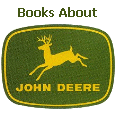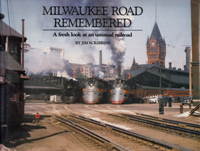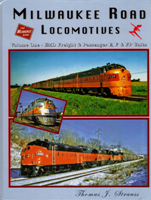| Electro-Motive E-Units
and F-Units. Brian Solomon, 2011. |
|
|
As the subtitle states, "The illustrated history of
North America's favorite locomotives." Longtime railroad enthusiast and
author Solomon surveys the history of the classic streamlined
diesel-electric locomotives that revolutionized both the nature of
railroading (from steam to diesel) and the nature of locomotive building
(from unique designs developed by and for each individual railroad, to
standard designs adaptable to any railroad). The book ranges from the
birth of the Electro-Motive Company to development of the "567" class
diesel engine, through the various models of E and F units in their
heyday, to the continued use today of Es and Fs on various railroads'
flagship executive fleets. Wonderful vintage color and black-and-white
photos, along with modern photos of surviving Es and Fs still in
operation, illustrate the text. As is often the case with general
history texts, I sometimes found myself wanting more detail: More nuts
and bolts, so to speak, about the various iterations of generator sets
or traction motors or various truck designs, or more operational details
from the perspectives of train crews or railroad executives. But all of
those subjects are at least touched on, and I recognize the limits of
time and pages--no one book could contain all the details various
readers might want. For fans of EMD's first-generation diesel
locomotives, this book is a keeper. |
|
|
|
| Classic American
Streamliners. Mike Schafer and Joe Welsh, 1997. |
|
|
Still one of my favorites, with lots of historical
photos and ads and well-written, detailed text about the glory years of
the great named passenger trains as well as their less-glamorous local
counterparts. I particularly enjoyed reading
about the design work done for the New York Central by
Henry
Dreyfuss and for the Pennsylvania Railroad by
Raymond
Loewy--the same industrial designers who created so many
classic designs for John Deere (Dreyfuss) and International Harvester
(Loewy). Republished in paperback in 2002 as
Streamliners - A History of the Railroad Icon. |
|
|
|
| |
|
| Twilight of the Great
Trains. Fred Frailey, 2010. |
|
|
An outstanding history of the decline and eventual
end of private-sector rail passenger service in the United States.
Veteran railroad author and
Trains magazine
correspondent Fred Frailey details the varying approaches taken by
different railroads to the pressures of competition from the highways
and airlines and of regulation by state and federal agencies, all of
them ultimately ending with the creation of Amtrak. Well
illustrated with black and white and some color photographs, along with
detailed diagrams illustrating routes and consists of major trains, this
is a well-written look at the passenger rail industry of the 1960s. |
|
|
|
| Outbound Trains In the
Era Before the Mergers. Jim Boyd, 2005. |
|
|
A beautiful collection of wonderful railroad
photographs from the 1960s and 70s, all in color, along with author and
photographer Jim Boyd's narration of some of his train-watching and
railroad-industry experiences and of the circumstances behind the
photographs. Most of the photos are of diesels,
given the era, but there are also some terrific shots of steam
locomotives then still in service on short lines and industrial yards.
Boyd covered most of the nation in his travels and the book reflects
that variety, with coverage of all sorts of railroads in all sorts of
places. Not a detailed history of any particular railroad so much
as a photographic record of the era, this is an excellent book. |
|
|
|
| |
|
|
The Call of Trains: Railroad
Photography by Jim Shaughnessy; and A Passion For
Trains: The Railroad Photography of Richard
Steinheimer |
| |
Stunningly gorgeous black-and-white photography of the late
steam and early diesel eras fills each of these terrific
coffee-table books, one focused on the work of Jim
Shaughnessy and the other on the work of Richard Steinheimer,
both with accompanying text by Jeff Brouws--himself a
passionate railfan and distinguished photographer. The
books follow identical approaches, each starting out with a
detailed introduction by Brouws before reaching the heart of
the book: Full-page or two-page spreads of
high-quality plates of many of the photographer's most
compelling portraits of railroading--often with railroaders
or other people in the photos, often at night or in bad
weather, chronicling the grit and energy of the industry and
those involved in it during the 1950s and 1960s. A
final section in each book reprints each photograph as a
much smaller image accompanied by a descriptive paragraph of
background information. At 224 and 192 pages
respectively, each 11" high and 12" wide, both books are
physically large as well as packed with great photos. |
|
|
|
|
|
|
| |
|
| F Units: The
Diesels That Did It. Jeff Wilson, 2000. |
|
|
A brief history of the Electro-Motive Division
F-series locomotives, which proved so versatile, economical, and
reliable that they "did it"--made the steam locomotive obsolete for most
railroading applications--in a remarkably short period of time. There's not a lot of text
here, but there are lots of great 1950s black and white photos, mostly
of F units in action but also including several terrific scenes from the EMD
plants where the locomotives were built. Posed publicity photos
from the various railroads are interspersed with evocative portraits
from distinguished railroad photographers including J. Parker Lamb, Jim
Shaughnessy, Richard Steinheimer, and others. Scale drawings and
model-by-model descriptions illustrate the differences between and
within each model, helpful for the railfan who needs to know, for
example, how to distinguish an FP7 from an F7, or an early F3 from a
late F3. |
|
|
|
| The Cars of Pullman.
Joe Welsh, Bill Howes, and Kevin Holland, 2010. |
|
|
Somewhat of a departure from most of the other books
I've collected, this one focuses not on a railroad or on types of trains
but on Pullman cars themselves. The Pullman Company was an early
innovator in developing comfortable sleeping cars, as far back as the
late 1800s, and grew to be the dominant manufacturer, owner, and
operator of sleeping cars and parlor cars--which it leased to the
railroads themselves, often in the styling and colors of the rest of the
given railroad's passenger trains. The detailed text is well
illustrated with lots of black and white and color photos. |
|
|
|
| |
|
| Great Passenger
Trains: Milwaukee Road Hiawathas, Great Northern
Empire Builder, Santa Fe Chiefs. Various authors and publication dates. |
|
|
|
|
A very good series of books, each
focusing on a single railroad's elite passenger trains and
covering their history from the earliest days through the
end of private-sector passenger trains and the advent of
Amtrak. Good text, lots of excellent color and
black and white photos, reproductions of advertisements and
other materials. I haven't read them yet, but I've
seen similar books in the series for
Baltimore and Ohio's Capitol and National Limiteds,
Burlington Zephyrs,
New Haven Passenger Trains,
Pennsylvania Railroad's Broadway Limited,
Southern Pacific Passenger Trains, and
Union Pacific Streamliners. |
|
|
|
|
|
|
| |
|
| Great Northern Color
Pictorial, Volume 1. Joseph Shine, 1992. |
|
|
This color pictorial illustrates the history of Great
Northern railway locomotives ("The Electrics, Last of Steam, and First
Generation Diesels") through excellent vintage color photographs with
captions detailing the time, place, and circumstances. For the
diesels, charts list each unit by number and show the builder,
horsepower, build date, the various renumberings and eventual
dispositions. Wonderful photographic record of Great Northern
motive power during the period between about 1950 and 1970. |
|
|
|
| Great Northern Color
Pictorial, Volume 3. John Strauss, Jr.,
1993. |
|
|
Another in the
Four Ways West
publishing series on the Great Northern, this book focuses on the Empire
Builder, GN's premier transcontinental passenger train. Author
John F. Strauss, Jr. served for years as a Traveling Passenger
Representative on the Empire Builder, and in the words of the publisher,
"...We have departed from an all color format and have adopted a format
utilizing color along with the author's extensive black and white photo
collection..." Period advertisements and
timetables supplement the photos and Strauss' detailed and well-informed narration. |
|
|
|
| |
|
| The Hiawatha Story. Jim Scribbins, 1971. |
|
|
At 265 pages, this
classic book by longtime Milwaukee Road
employee Jim Scribbins lavishly chronicles the railroad's
Hiawatha trains. In an era when passenger trains symbolized
luxury and speed, the Milwaukee Road drew inspiration from
Longfellow: "Swift of foot was Hiawatha; He could shoot an
arrow from him, And run forward with such fleetness, That the arrow fell
behind him!" Thoroughly researched, well written, illustrated with
lots of great vintage photos. Republished in
paperback in 2007. |
|
|
|
| Milwaukee Road Remembered. Jim Scribbins, 1990. |
|
|
The definitive history of the Milwaukee Road, written
and illustrated with Jim Scribbins' trademark care, attention to detail,
and firsthand knowledge. Many outstanding black and white photos,
along with eight pages of full color photos in the center of the book,
complement the detailed and easy-reading text. Still the one
must-have book on the Milwaukee Road, out of print in the original hard
cover but available used, and republished in
paperback
in 2008. |
|
|
|
| |
|
| The Milwaukee Road In
Color. Various authors and publication dates. |
|
|
|
|
|
|
|
|
|
|
| [Various Railroads] In
Color. Various authors and publication dates. |
|
|
|
|
|
|
|
|
|
|
|
These "...In Color" books from
Morning
Sun Books, each
focusing on a different railroad or a different aspect of a
given railroad, are composed primarily of excellent color
photographs from the 1950s, 60s, and 70s with detailed
captions. An extra paragraph or two sometimes
introduces a section of photos from a particular district or
theme, but the books are about the photos and captions
rather than written histories. They're great
references for fans of the particular railroad or for
hobbyists looking for prototype details of trains, yards, or
trackside structures. I have the ones shown here but
I've also seen them for the
Lehigh Valley,
New York Central,
Northern Pacific, and
Union Pacific, and expect more are out there, typically with multiple
volumes per railroad. |
| |
|
| The Great Northern
Railway - A History.
Ralph Hidy, Muriel Hidy, Roy Scott, Don Hofsommer, 1988. |
|
|
A meticulous and scholarly history of the Great
Northern, from its Minnesota origins in the 1850s, to the
turn-of-the-century Empire Building decades under James. J. Hill, to the
1970 merger with the Northern Pacific that created the Burlington
Northern. Well illustrated with vintage black and white photos,
this book--at 360 pages--is nonetheless more of a business case study
than a pretty coffee table book, reflecting the Harvard Business School connections of its authors and publisher.
Republished in
paperback in 2004. |
|
|
|
| Milwaukee Road
Locomotives, Volume 1. Thomas Strauss, 2006. |
|
|
This page is under construction. |
|
|
|
| |
|
| |
|




























